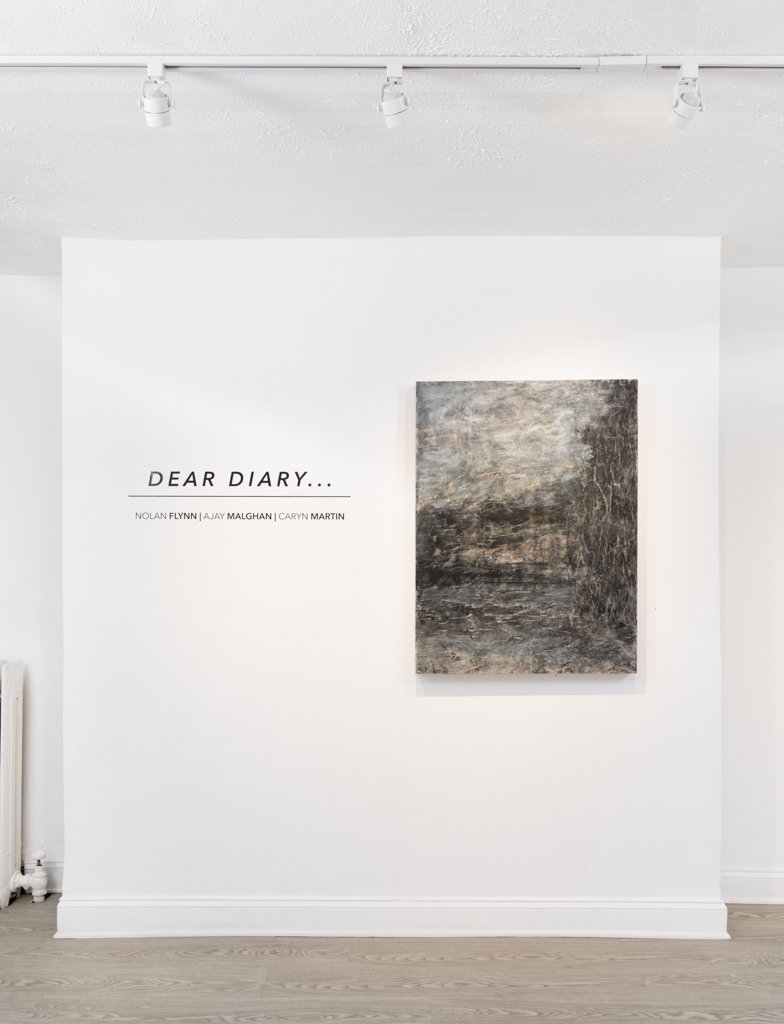Catalyst Contemporary presents Dear Diary, a mixed media group exhibition featuring the works of Nolan Flynn, Ajay Malghan, and Caryn Martin. The bodies of work present in the gallery were made as an intuitive and inspired response to the pandemic. The show highlights artists who utilize their various techniques as a cathartic way to process events and emotions as if in the keeping of a diary.
The first works encountered in the gallery are Baltimore artist Caryn Martin’s monotype collages and large print installations. In her printmaking process, the plate is inked once, using marks that imply patterns and forms found in nature. She then adds water in multiple stages and pulls many prints until the ink is fully removed from the plate. The paper, often tracing paper, is allowed to curve, curl, wrinkle, fold, and warp as it responds to the ink and water.
At the start of the pandemic, Martin’s normally large-scale single works shifted to multi-layered installations of prints that appear to push off the wall. These pieces are contained but also seem to break the traditional frame and two-dimensional surface. They are both unified and divided; heavy yet light. This opposition of formal elements reflects Martin’s range of emotions while adjusting to life during a pandemic. What we see now are atmospheric landscapes and the shifting nature of emotions, both of our own and of Martin’s.
Opposite these works in the main gallery are the mixed media, abstract scrawlings and embryonic imagery of Salt Lake City artist, Nolan Flynn. Flynn created these pieces with no predetermined idea or aesthetic in mind, typical of his work in recent years. The markings left on the stretched canvases remind us of a cryptic sketchbook, revealing Flynn’s personal thoughts and experiences during the last two years. Much of the stimuli comes from Flynn’s banal observations, lucid dream states, and the influence of global events through various media. Like a serial story, or a journal awaiting the next entry, the revelations unfold in the next rendition, the next canvas, but only to the extent that they conceal more than they reveal: an inescapable movement.
Flynn’s canvases are covered in a mixture of graffiti-like notes, sometimes thin and ghostly brush strokes. Others are thick - almost impasto, dabs of paint. In luka shade (2020, 60 48 inches), we see various text scribbled across the canvas such as: “contributing factors,” “self deprecating,” and “48 hours of anxiety,” which is written twice on top of each other and encircled in vivid, hot red. What comes through the mark making is an almost frantic and obsessive need to notate and record what comes into his brain, whether logical or not.
In The Backroom Gallery are a selection of works from Montgomery county artist, Ajay Malghan’s ongoing series, I can’t remember what I was trying to forget. Bright, vivid and explosive in color, Malghan’s pieces resemble paintings but are much more ephemeral as they are loose pigments on linen. Malghan sprays each linen canvas with water, sprinkles the pigment onto the surfaces where it is moved around by the water. Malghan describes his process similar to bread making with just flour and water. These pieces shimmer when one walks by them and when placed under different lighting conditions. In a very mundane fashion, each piece is titled with the date they were made and the order they were made in such as “7/16/20 002” (33 x 45 inches). Malghan’s works are the purest form of emotional projection and examines the state of being “in between.”
While the front room is filled with various forms of the artists journaling and putting themselves in their methods of mark making, The Backroom Gallery is an attempt to retract the artist and to empower one’s feeling of isolation in that stripping away of oneself. Malghan’s technique relies not on the happenings of the mind but instead focuses and utilizes the purest form of expression, movement of the body.
Dear Diary looks at the ways artists responded emotionally, rationally, and creatively to life during COVID. Their work is a look at processing trauma, bringing order to the chaos of the shift in lifestyle and the translation of their emotions into physical objects. The majority of the work in the gallery was made during 2020-2021, in a time where most of us experienced a cataclysmic shift in our collective day to day lives. The artists invite you to encounter their private experiences and in between each daily record making, you may find your own experience of the past two years reflected back at you.








